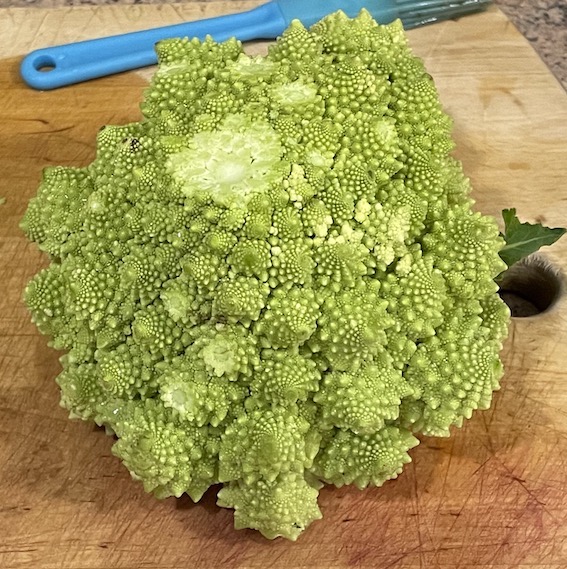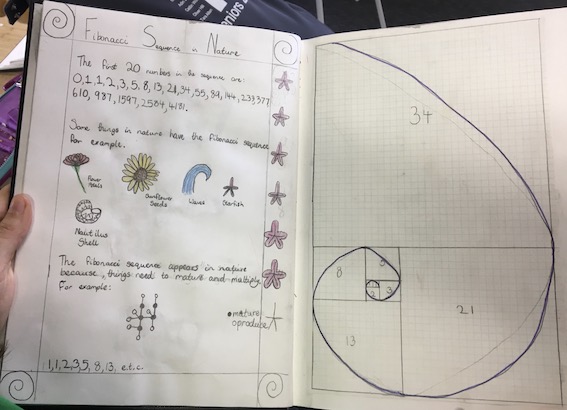Happy Fibonacci Day (November 23rd – 11 23)
Fibonacci lived from 1180-1250. He was the son of an Italian merchant. He developed a passion for numbers and discovered the following sequence that can be observed in leaf arrangements, flower segments, pine cones, etc.:
0, 1, 1, 2, 3, 5, 8, 13, 21, 34, 55, …
If you look closely the pattern is developed by adding the previous two numbers together.

If you look at a large pine cone you can see that the scales of the cone form regular spirals – some go to the left and some to the right. If you count the numbers of scales at each level, you will find that they follow the Fibonacci sequence. This very brief overview video of Fibonacci in Nature is a useful introduction.
Introducing Fibonacci to children
Get the children to gather some loose material – whatever is readily available in the wood, e.g. cones or sticks.
As a group, layout the material in the Fibonacci sequence on a light coloured cloth so that the children can see the pattern and write down the numbers beside this, e.g. with sticks (NB you can use tally marks, it’s harder to show in a blog)
1 I
1 I
2 II
3 III
5 IIIII
8 IIIII III
13 IIIII IIIIII III
It’s unlikely that the children will understand the pattern. However, you can demonstrate how it is created by moving the sticks and encouraging the children to try doing this. By manipulating the sticks, it can help children create larger numbers quickly.
It’s quite nice to tell the story of Mr Fibonacci and how he used pine cones to practise counting… 1,1,2,3,5,8,13,21,34, etc. (demonstrate this with a pine cone).
This was a problem for him. For example when he went to buy food in a shop he always counted out the wrong amounts. If his lemons cost 10 lire, he couldn’t count the number 10 so he always gave 13 coins. Everybody laughed at him and thought he was very silly. Over time, he grew more and more unhappy.
One day a little girl who had just learned to count realised his problem. When she saw Fibonacci using a pine cone to count, she gave him a daisy and showed him how to pull the petals off and count like everybody else. So Mr Fibonacci was very happy…but to this day we are very pleased about the way he counted because he showed the world one of the cleverest number patterns of all!
Make your own Fibonacci pattern art
Collect cones, flowers, stones, leaves or other loose material and try and arrange to create a Fibonacci pattern of your own. Which materials work best for this? Does it depend upon shape, size, weight or another factor?
Think about how this can be followed up with an art activity (indoors or out) that uses the Fibonacci pattern as an inspiration.
Fibonacci woodland poems
The beginning of the Fibonacci sequence can be used to create poetry or stories based upon syllables in each line. These are known as “Fibs” and tend to be six lines in length with a total of twenty syllables, e.g.
1 Trees
1 in
2 the woods
3 standing tall
5 waving their green leaves
8 catching and filtering sunlight
So I’m delighted that approximately 800 years ago, Fibonacci enriched our world a little more by his mathematical observations of nature that remain relevant today. If you have children in an upper primary or lower secondary class then creating simple journal entries can also help explain the relationship of this number pattern to nature through the use of the golden spiral.

. There are several useful explanations and introductions which can also be of use when planning a Fib focus. Have a look here and here. Oh and enjoy this video which is thee first of three in a series:
This blog post was originally published in May 2010.




















This is a great idea! Hope you don’t mind by I think I’ll be adding it to my Fun Friday list of ideas! 🙂
Be my guest! Thanks Debi. I think it would be a lovely thing to do tomorrow. The bag of pine cones is going with me to a nursery!
Thank you for this super idea. Is there a link to the “lovely poster” you mentioned?
Thank you!
Sigh… heaven! This is what gets my brain ticking and what would have sooooo got me into maths as a child. Thanks Juliet 🙂